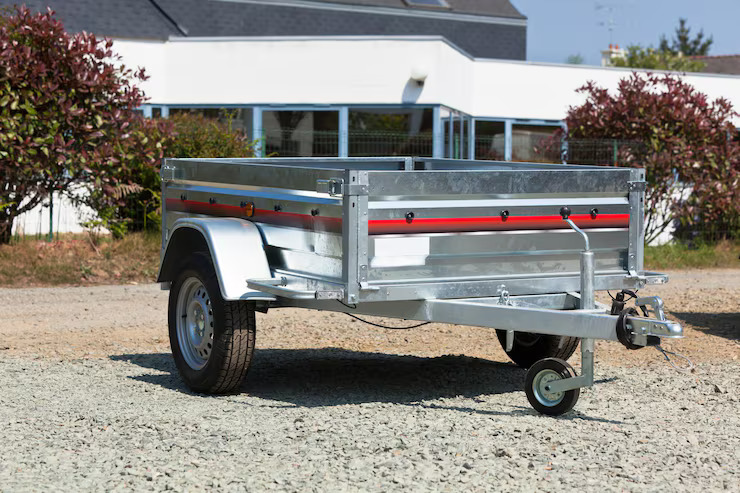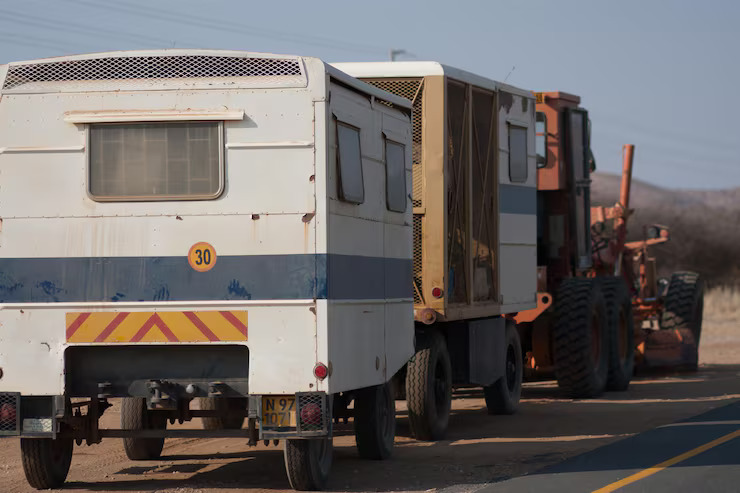Table of Contents
Key Takeaways





Selecting the right trailer is essential for safe and efficient transport. Each option serves a specific purpose depending on the type of load, hauling distance, and working environment. From moving heavy machinery to handling oversized cargo, choosing the right setup ensures better control, balance, and performance on the road.
Here are the most common types of hotshot trailers used across professional hauling and logistics operations:

Key Factors to Consider for Hotshot Trailer
Trailer Type
- Gooseneck: Gooseneck trailers are the preferred option in hotshot trucking because they provide superior control and balance for heavy loads. They connect over the truck’s rear axle, making them ideal for large machinery and equipment often handled in warehouse logistics.
- Flatbed: Flatbeds offer flexibility for different types of freight, while step decks handle tall cargo that exceeds standard height limits. Equipment haulers are commonly used for relocating heavy-duty machinery, ensuring the hotshot truck remains balanced and compliant with road regulations. Each trailer type enhances performance based on the hotshot meaning—efficient and reliable delivery under tight deadlines.
- Step Deck: Features a lower deck, allowing for taller loads that would otherwise exceed height restrictions.
Load Weight
The weight of the cargo directly determines the ideal hotshot trailer type. Most hot shot trailers can handle between 10,000 and 14,000 pounds, but some exceed 20,000 pounds depending on axle design.
Accurate load calculations are essential to ensure proper towing performance, especially when operating under the rules of what is hotshot trucking, which emphasizes safety and capacity limits. In warehouse logistics, knowing exact load weights prevents overloading and minimizes maintenance issues.
Maneuverability
- Gooseneck: Provides better stability and a tighter turning radius than bumper pulls, making it ideal for tight warehouse spaces or urban routes.
- Flatbed/Equipment Haulers: Offer strong maneuverability due to shorter lengths and deck-over designs.
Vehicle Compatibility
Not every truck can safely tow every trailer. Compatibility depends on factors such as the hitch setup, vehicle strength, and load capacity. While bumper-pull trailers are easier to connect, gooseneck setups generally provide greater balance and control for heavier hauls.
How to Choose the Right One for Your Hauling Needs
Assess Typical Loads
Identify the materials most often transported. For example, those working in warehouse logistics may frequently haul crated goods or palletized equipment using a hotshot trailer. The hotshot meaning extends to adaptability—trailers should be capable of carrying diverse loads without compromising safety. A hot shot trailer with reinforced decks and ramps supports smooth loading and unloading, reducing downtime between deliveries.
Evaluate Vehicle Capacity
Every hotshot truck has unique towing limits, which should align with the chosen hotshot trailer. Reviewing GCWR and GVWR helps ensure that both vehicle and trailer can handle operational demands safely. In warehouse logistics, trucks with stronger torque and heavy-duty suspension systems are preferred.
Prioritize Stability and Safety
Stability defines every successful haul. A gooseneck hot shot trailer minimizes sway, which is essential when operating in congested or uneven terrain. Safety systems like trailer brakes and weight distribution hitches help protect the hotshot truck and load. This focus on stability reflects the true hotshot meaning—precision, reliability, and on-time delivery within complex warehouse logistics operations.
Consider Route Conditions
Urban routes with narrow access points may call for smaller hotshot trailers, while rural highways favor longer, heavier setups. Operators must assess elevation, turning space, and available loading zones.
Factor in Legal Compliance
Legal standards may vary by state, particularly regarding weight limits, trailer size, and Commercial Driver’s License requirements. A professional hotshot trucking operator ensures that every hotshot trailer meets Department of Transportation guidelines. Proper registration and inspection keep both the hotshot truck and cargo compliant, safeguarding warehouse logistics operations from potential disruptions.
Which Type of Hot Shot Trailer Is Used Most Often?
The gooseneck hotshot trailer remains the industry standard due to its durability, strength, and superior balance. It’s the preferred option among professional drivers and warehouse logistics providers who handle heavy, long-distance freight.
In essence, it represents the purest form of what is hotshot trucking—fast, efficient, and reliable. Whether hauling machinery, crates, or modular units, this type of trailer ensures the hotshot truck performs consistently across varied terrains and job types.
How Can Towing Capacity Be Determined?
Towing capacity for a hotshot truck is based on its engine output, frame design, and hitch configuration. Manufacturers list this information in the vehicle manual. A well-matched hotshot trailer ensures safe, legal operation without exceeding load limits.
Key factors that affect towing capacity include:
- Vehicle type: Heavy-duty trucks handle larger loads than light-duty pickups.
- Hitch system: Gooseneck hitches typically allow higher towing capacities.
- Trailer weight: Always account for both cargo and trailer weight combined.
How Can Towing Capacity Be Determined?
Towing capacity for a hotshot truck is based on its engine output, frame design, and hitch configuration. Manufacturers list this information in the vehicle manual. A well-matched hotshot trailer ensures safe, legal operation without exceeding load limits.
Key factors that affect towing capacity include:
- Vehicle type: Heavy-duty trucks handle larger loads than light-duty pickups.
- Hitch system: Gooseneck hitches typically allow higher towing capacities.
- Trailer weight: Always account for both cargo and trailer weight combined.
What Are the Legal Regulations for Operating a Hotshot Trucking?
Operators in hotshot trucking must follow FMCSA and DOT safety rules. These govern registration, inspections, and hours of service. Every hotshot trailer must meet roadworthiness standards to ensure safe transit within warehouse logistics networks.
The principles behind what is hotshot trucking rely on compliance and reliability, not just speed. By maintaining strict adherence to legal and operational guidelines, professionals uphold the integrity of every load and deliver consistent performance across all routes.

Frequently Asked Questions
What makes hotshot trailers different from standard trailers?
Hotshot trailers are smaller and more versatile, designed for time-sensitive loads. They can be pulled by medium-duty trucks instead of large tractors. This makes them ideal for quick hauls and easier navigation in tight spaces.
How often should hotshot trailers be inspected?
Inspections are typically done before every haul to ensure safety. Most checks focus on tires, lights, and hitch connections. Regular professional servicing helps prevent breakdowns.
What types of loads are best suited for hotshot hauling?
Hotshot trailers carry machinery, construction materials, and palletized goods. They work well for loads that are urgent but not large enough for full-sized trucks. Their flexibility makes them useful across many industries.
Can hotshot trailers operate in adverse weather conditions?
Yes, but with caution. Drivers should slow down and secure loads properly during rain or icy conditions. Stability and traction are key to safety.
What kind of maintenance do hotshot trailers require?
Regular checks on tires, brakes, lights, and hitches are essential. Preventive maintenance avoids costly issues during hauls. Keeping service records also helps with compliance.

Optimize Warehouse Logistics Operations in New York, NY!
Enhancing warehouse logistics in New York, NY starts with a dependable team that understands the demands of efficient storage, transport coordination, and inventory flow. Warehouse Logistics By Best delivers professional handling, precise scheduling, and coordinated movement across facilities to keep operations running without delay. Designed for both commercial and industrial needs, every solution focuses on accuracy, safety, and reliability.
Contact Warehouse Logistics By Best today to schedule expert warehouse logistics support in New York, NY!

